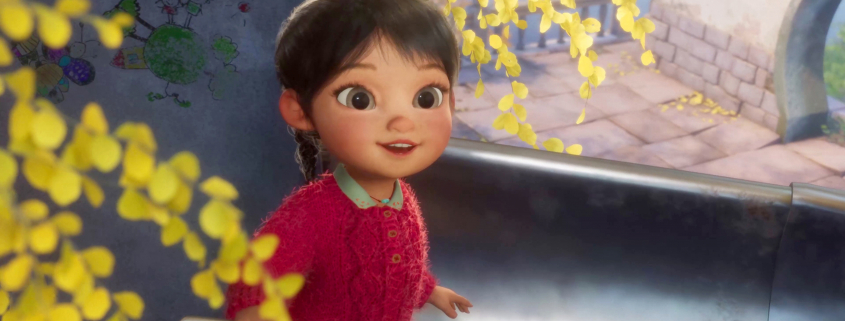‘WiNDUP’ is a heartwarming tribute to hope and healing

Photo courtesy of Cinematic Red PR.
This review contains spoilers.
In trying times, the small things can remind us of what we really treasure. Such is the story of “WiNDUP,” a 9-minute animated short created in real-time through animation software platform Unity. As the product of a collaboration of artists working remotely from around the world, the very existence of this film is a testament to the importance of global connections and the ties that keep us together.
On Tuesday, a 45-minute virtual event featured a live screening of the film and a Q&A with director Yibing Jiang and animation director Jason Keane, moderated by Variety Film Awards editor Clayton Davis.
“WiNDUP” chronicles the bond between an ailing daughter named Kiki and her father. The story is an emotional one, as Kiki’s father repeatedly attempts to connect with his unconscious daughter by playing a windup music box of her favorite tune. There’s a larger story reflected here, in an especially poignant tale about love and worry as part of the human experience.
Yet, the personal moments of the film are the most compelling. There is no dialogue, but the mere sound of the music box winding becomes a vehicle to convey the father’s love for his daughter. Through a montage of quiet scenes spent at the hospital, the music box is the only constant amid the ventilator’s whirring and an unconscious Kiki. “WiNDUP” then takes a more mystical turn when Kiki journeys through beautiful and unfamiliar landscapes in her dreams as she follows the music. In the hospital room, the music box breaks and the father begins to sing instead. In what proves to be the film’s most emotional moment, Kiki opens her eyes to her tearful father.
“WiNDUP” director and writer Yibing Jiang is a Chinese American filmmaker from Wuhan, a city that has recently made international headlines during the pandemic. Yet Jiang takes a more nuanced approach to her hometown, one that doesn’t make a spectacle out of illness or dehumanize its origin. Instead, “WiNDUP” offers a willingness to delve beyond the stigma of illness and into the lives of those who are most affected by it.
Themes of love and life are central to the film. They’re also, Jiang reflects, why health and illness feature most prominently in discussions of the storyline of a familial bond. These themes are motivated by her own experiences growing up as a child who was often sick and the significance of the film during the coronavirus pandemic.
“[My parents] spent countless nights taking care of me,” Jiang said. “When I got older, I started to empathize with my parents … I remember when we were animating the hospital sequence when the father actually was sitting on the floor and [feeling] hopeless. [In] that moment, I can totally sympathize with the pain.”
Davis echoed similar sentiments about the film’s contemporary relevance amid concerns about illness and its impact on individuals.
“[The story] is deeply personal, and we’re in a time right now where the pandemic is living and ravaging its way through the world,” Davis said.
Visually, the animation acknowledges the darker side of illness while also paying a stunning testament to the power of imagination. The muted, darker shades of the hospital room are placed in contrast with the pastel hues of Kiki’s personal dreamland and the magical qualities of the Asia-inspired architecture. Such vivid imagery renders the characters and setting distinctly ethereal but also fundamentally believable.
In the process of giving the story life, Keane took into account the idea of character-driven animation.
“[Kiki] has this spark of energy into her, and it was perfect for Kiki because we wanted to contrast that love of life, arts [and] music versus her situation,” Keane said. “In terms of animation and characters and personality, [the animation team was] able to put their own kind of history and their feelings within the scenes that they had, and it really brought the characters to life.”
When asked what motivated the creators to make a dialogue-free film, Jiang expressed that previous iterations of “WiNDUP” had contained dialogue. The decision to remove spoken language was a strategic choice of accessibility.
“We believe that music is a universal language, and the theme of the story is universal, so we really want people all over the world able to connect with it,” Jiang said.
For Jiang, “WiNDUP” may be specifically drawn from her own past, but can provide a global space for empathy. It’s a story about the relationships between people and the lives we share. “Life imitates art, I think, especially now — a time when people around the world are isolated and craving for connections and also preoccupied with the health and well-being of loved ones,” Jiang said.
Most of all, though, the story is one about healing. It’s not only about the power of music but also about hope and the worldbuilding that hope engenders. “WiNDUP” creates a world that allows us to acknowledge our present yet cultivate a sense of possibility regarding the uncertainties of the future. There’s a beautiful message in the film — in a world where love takes the shape of a music box, it only takes our imaginations to help us find our ways back home.
“WiNDUP” is available for viewing online through YouTube.

